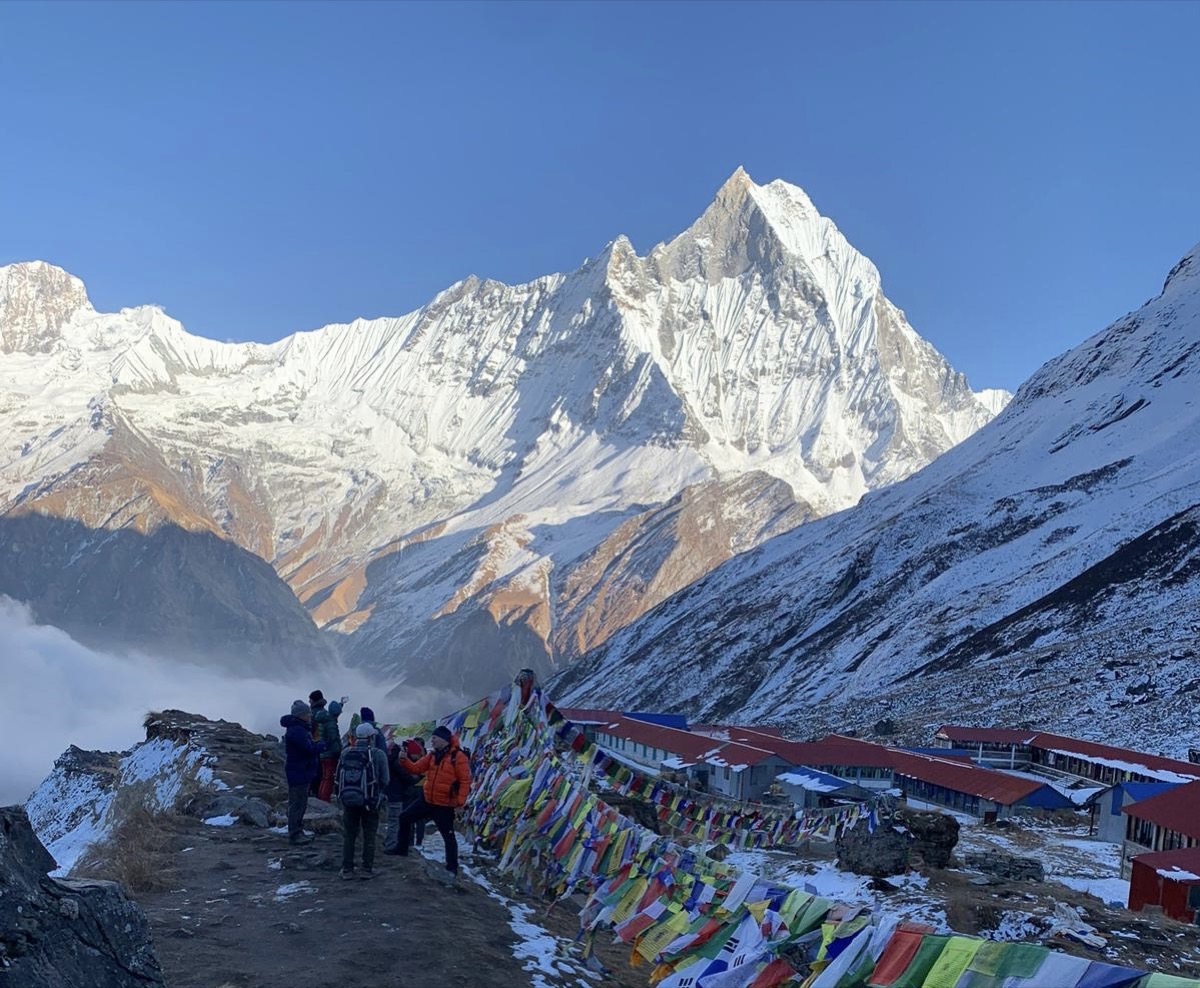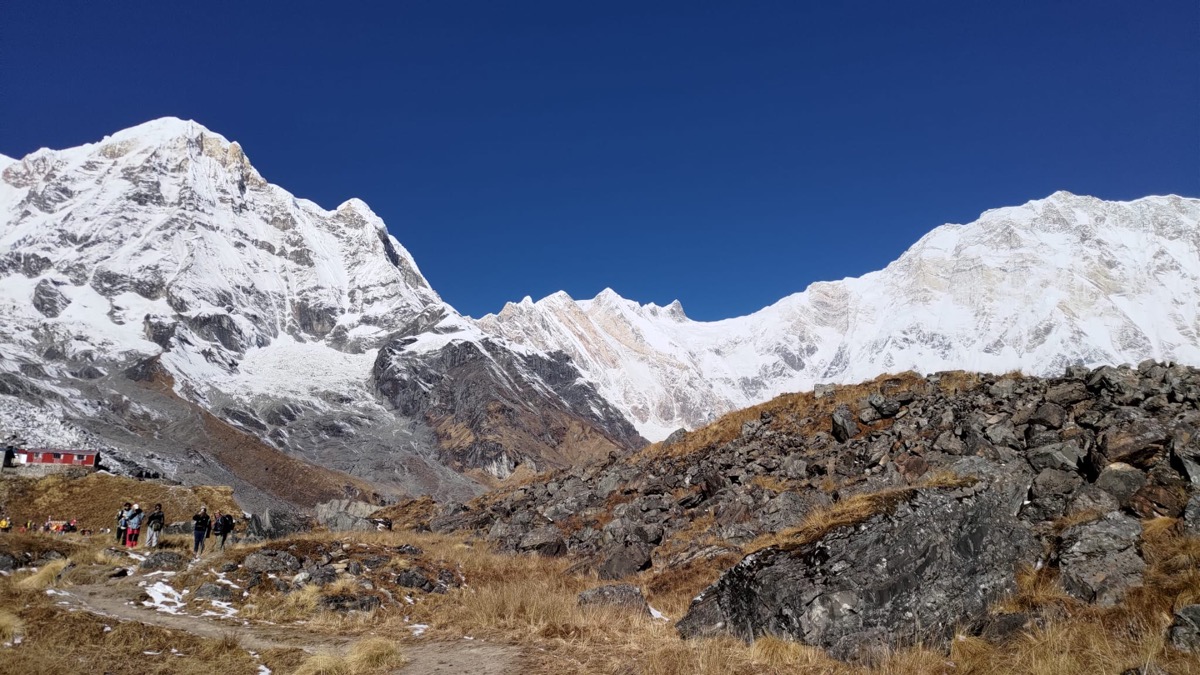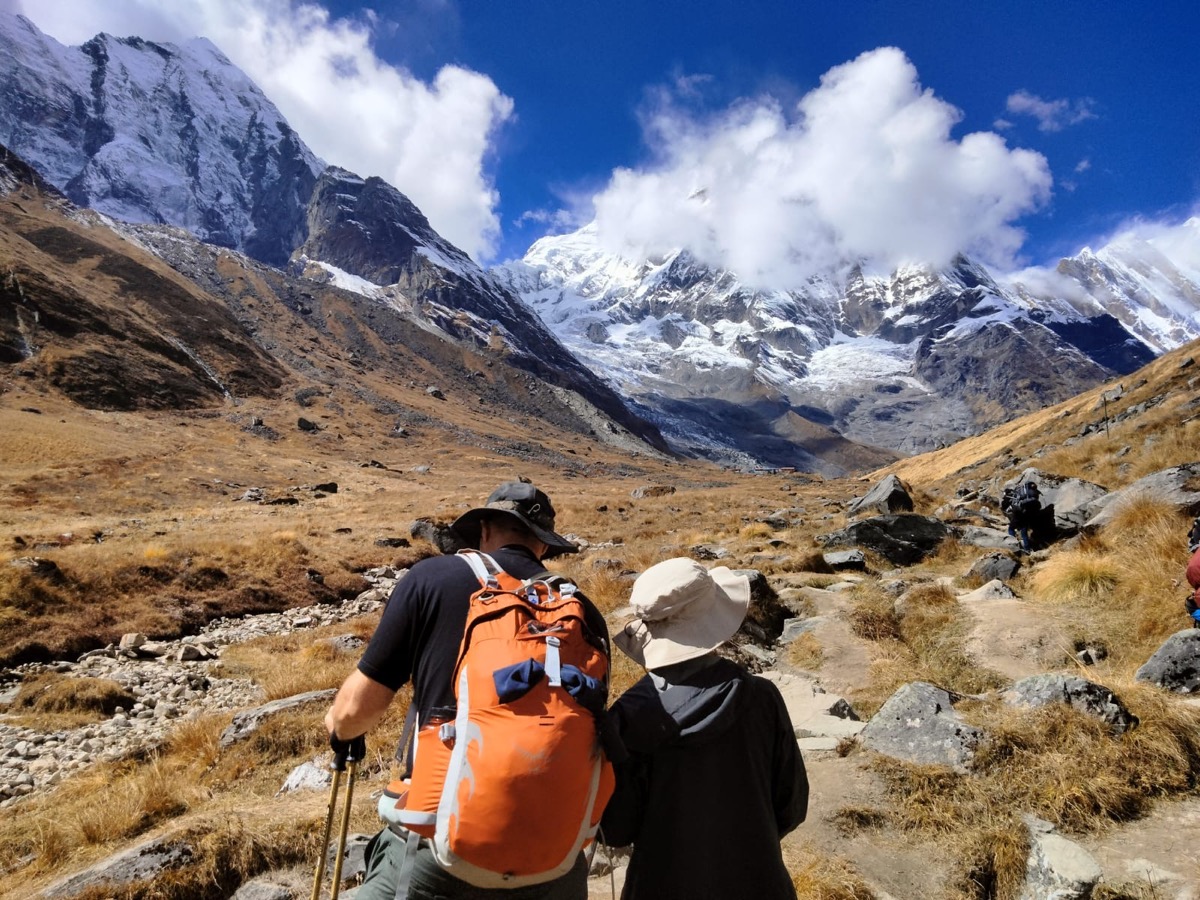Understanding Annapurna Base camp Trek
The Annapurna Base Camp Trek is a renowned trekking route nestled in the heart of Nepal's Himalayas, offering adventurers a stunning blend of natural beauty and cultural richness. It is a journey that takes trekkers through diverse landscapes, from lush subtropical forests and terraced rice paddies to alpine meadows and rugged terrains. As trekkers progress, they are treated to awe-inspiring views of towering peaks, including the majestic Annapurna Massif, Machapuchare, and Hiunchuli.
This trek is not just about the breathtaking scenery but also a cultural odyssey. Trekkers pass through charming villages inhabited by the Gurung and Magar communities, gaining insight into their traditional lifestyles and hospitality. Local teahouses provide accommodations, offering a chance to experience regional cuisine and interact with fellow travelers.
The trek begins in Nayapul and typically takes around 7-12 days to complete, depending on the chosen route and pace. The trail winds its way through the Annapurna Conservation Area, home to diverse flora and fauna, including rhododendron forests that burst into color, especially during spring.
The Annapurna Base Camp Trek is accessible to both novices and experienced trekkers, although a reasonable level of fitness is required. With each step, the trek reveals new challenges and rewards, culminating in the breathtaking sanctuary of the Annapurna Base Camp itself.

The Ideal Trekking Seasons: Spring Vs. Autumn
The ideal trekking seasons for Annapurna Base Camp are spring and autumn, each offering unique advantages that cater to different preferences.
Spring, from March to May, is a vibrant time to experience the trail. As the snow begins to melt, the landscape bursts into life with blooming rhododendrons painting the valleys in vivid hues. The moderate temperatures make trekking comfortable, and the days are generally longer, providing ample daylight for exploration. This season also offers clear skies in the afternoons, though mornings can sometimes bring clouds.
Wildlife is more active, adding an exciting element to the trek.
Autumn, which spans from September to November, is perhaps the most popular season for trekking in Annapurna. The post-monsoon period ensures that the skies are spectacularly clear, offering unobstructed views of the majestic peaks. The temperatures are cooler than in spring but remain pleasant, making for an ideal trekking climate. The trails are dry, reducing the challenges posed by slippery paths, and the cultural festivities like Dashain and Tihar add a rich cultural dimension to the journey.
Both seasons have their own allure; spring's floral beauty contrasts with autumn’s crystal-clear vistas. Ultimately, the choice between these seasons depends on whether you prioritize colorful landscapes and wildlife in spring or unparalleled mountain views and cultural experiences in autumn.
Weather Conditions and Temperature Variations Throughout The Year
The weather conditions and temperature variations at Annapurna Base Camp play a crucial role in planning the perfect trek. Throughout the year, the region experiences distinct seasonal changes that can dramatically affect the trekking experience.
In the spring months of March to May, the weather is generally moderate, with temperatures ranging from 16°C to 22°C during the day and cooler nights. This period is characterized by blooming rhododendrons and clear skies, making it a popular time for trekkers. The monsoon season, which spans from June to September, brings heavy rainfall to the Annapurna region. These months see frequent downpours, leading to muddy trails and potential landslides, with daytime temperatures between 18°C to 25°C.
Post-monsoon, the autumn months of October and November offer some of the best trekking conditions, with crisp, clear skies and comfortable temperatures ranging from 15°C to 20°C during the day. Nights can be chilly, especially at higher altitudes. As winter arrives from December to February, temperatures drop significantly, often reaching lows of -10°C at night. Despite the cold, the crisp air and snow-capped peaks attract those seeking a quieter and more serene trekking experience.
Understanding these variations is essential for selecting the most suitable time for your Annapurna Base Camp adventure, balancing weather conditions with personal preferences for temperature and crowd levels.

Monsoon Season: Challenges And Considerations
Trekking to Annapurna Base Camp during the monsoon season, which spans from June to September, presents both challenges and unique considerations. One of the primary concerns is the heavy rainfall that characterizes these months. The trails become slippery and muddy, increasing the risk of slips and falls. Additionally, landslides and flooding are more frequent, sometimes leading to unpredictable trail conditions and potential route closures.
Visibility during the monsoon is often compromised due to persistent cloud cover and fog, which can obscure the stunning mountain vistas. However, for those willing to embrace the adventure, the lush greenery that flourishes during the rains provides a different kind of beauty, with terraced fields and vibrant flora at their peak.
Leeches are another consideration, particularly in lower altitudes, and trekkers should prepare by wearing appropriate clothing and carrying salt or sprays for protection. Accommodations may be more readily available, with fewer trekkers on the trails, offering a quieter, more solitary experience.
Planning and flexibility are crucial during the monsoon. Engaging a knowledgeable guide who can navigate the changing conditions and adjust plans as needed can enhance safety. While the challenges are significant, trekking during this season offers a serene connection to nature and an opportunity to experience the Annapurna region in its most verdant state.
Winter and Off-Season Trekking: What to Expect
Trekking to Annapurna Base Camp during the winter and off-season offers a unique and serene experience, distinct from the bustling peak months. The landscape is transformed into a snow-laden wonderland, with pristine trails and stunning views unobstructed by the usual crowds. While the beauty is unparalleled, trekkers should be prepared for challenges specific to this time of year.
Winter temperatures can plummet significantly, especially at higher altitudes, so it's crucial to have proper cold-weather gear. This includes insulated clothing, sturdy boots, and high-quality sleeping bags. The trails can be covered in snow and ice, which might make the trek more demanding and slow-paced, requiring greater endurance and caution.
With fewer fellow trekkers around, accommodations are more readily available without the need for advance bookings. However, many lodges in higher regions could be closed due to harsh weather, so planning your itinerary with flexible overnight stops is wise. Experienced guides are strongly recommended as they can provide insights and ensure safety on the less-traveled paths.
The off-season also offers an opportunity for solitude and reflection, allowing a more personal connection with the dramatic landscapes. For those seeking adventure and tranquility away from the usual trekking hustle, winter provides a rewarding, though demanding, experience in the Annapurna region.
Why Timing Matters for the ABC Trek
● Mountain Visibility: Annapurna, Machhapuchhre, and Hiunchuli, the great Himalayas, come into view at the best distance from very far up during spring and autumn since they are the best seasons with blue skies.
● Weather Condition: Season alters the temperature, and rain and snowfall also contribute greatly to the trail condition and safety, and comfort as well. Stable weather of autumn and spring offers a more comfortable trekking experience.
● Trail Safety: Monsoon is a period of heavy rain and wet roads due to landslides, and winter is a season of snow and ice to clear the mountain highway. Therefore, the correct choice of season is required.
● Crowd Level: These are the two perfect times to hike in Nepal by way of crowds on the trails, but monsoon and winter are off-season trekking months with minimal or no humanity on the trails and a very generous stillness.
● Accommodation & Logistics: Teahouses and lodges require reservations in high season. Peak seasons tend to book quickly, though off-season treks are simpler and less expensive to find.
● Cultural Experiences: Autumn brings major Nepali festivals like Dashain and Tihar, which can add a rich cultural layer to your trekking experience.
● Flora and Fauna: Spring showcases blooming rhododendrons and active wildlife, making it a favorite for nature enthusiasts and photographers.
Planning Your Trek: Timing For the Best Experience And Views

Planning your trek to Annapurna Base Camp requires careful consideration of timing to ensure the best experience and breathtaking views. The trek is open throughout the year, but the peak seasons are spring and autumn due to their favorable weather conditions. During spring, from March to May, the trail comes alive with blooming rhododendrons and lush greenery. The temperatures are mild, making the trek comfortable, and the clear skies offer stunning panoramic views of the surrounding peaks.
Autumn, spanning from September to November, is another ideal time for trekking Annapurna Base Camp. The post-monsoon season provides crisp air, stable weather, and exceptional visibility, allowing you to capture the grandeur of the Himalayas in all their glory. The trails are bustling with fellow trekkers, creating a vibrant atmosphere. However, be prepared for crowded pathways and book accommodations in advance.
While summer, from June to August, brings monsoon rains that can lead to slippery trails and potential landslides, the solitude and lush landscapes might appeal to those seeking a quieter trek. Winter, from December to February, offers a more challenging experience with colder temperatures and snow-covered trails, rewarding adventurous trekkers with mesmerizing views and serene landscapes. Determining the right time to embark on this journey will significantly enhance your overall trekking experience.
Annapurna Base Camp Trek Annapurna Circuit Trek Annapurna Luxury Trek Ghorepani Poon Hill Trek

